Pore Clogging Checkers: Identify Ingredients for Clear Skin
What Is a Pore Clogging Checker and Why Do You Need It?
Clear skin starts with understanding what goes into the products you use. While skincare can seem overwhelming, especially with countless options on the market, one major factor to consider is whether the ingredients in your products might be clogging your pores. This is where a pore-clogging checker comes in.
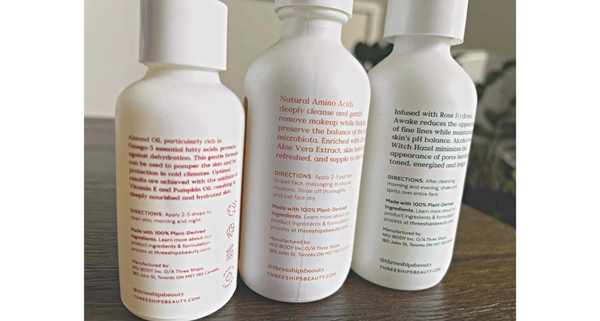
A pore-clogging checker is an online tool designed to help you analyze skincare product ingredients for their potential to block pores. By identifying comedogenic (pore-clogging) ingredients, this tool can guide you in choosing products that are less likely to contribute to breakouts, blackheads, or acne.
Tired of breakouts from products claiming to clear your skin? The answer could be hidden in the ingredient list. Use the Pore Clogging Checker at PoreCloggingChecker.org to uncover problem ingredients and discover safer alternatives.
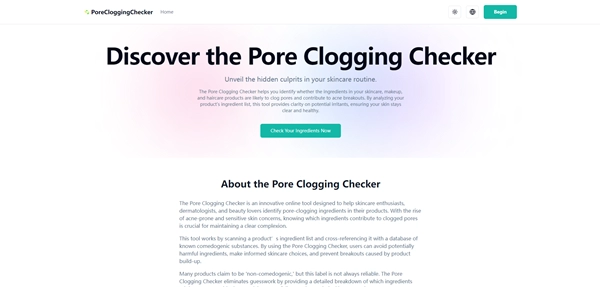
Not sure how we compare to other tools? Unlike general ingredient checkers, PoreCloggingChecker.org focuses specifically on comedogenicity. This means you get tailored insights to prevent clogged pores and maintain healthy skin.
Understanding Pore Clogging Ingredients
What Are Pore Clogging Ingredients?
Pore-clogging ingredients, also known as comedogenic ingredients, are substances that can block your skin's pores, leading to acne, whiteheads, blackheads, or irritation. Common culprits include oils, waxes, and certain emollients often used to moisturize the skin. While these ingredients can be beneficial for dry skin, they may cause issues for those with oily or acne-prone skin.
Examples of common pore-clogging ingredients include:
- Coconut Oil
- Isopropyl Myristate
- Lanolin
- Algae Extracts
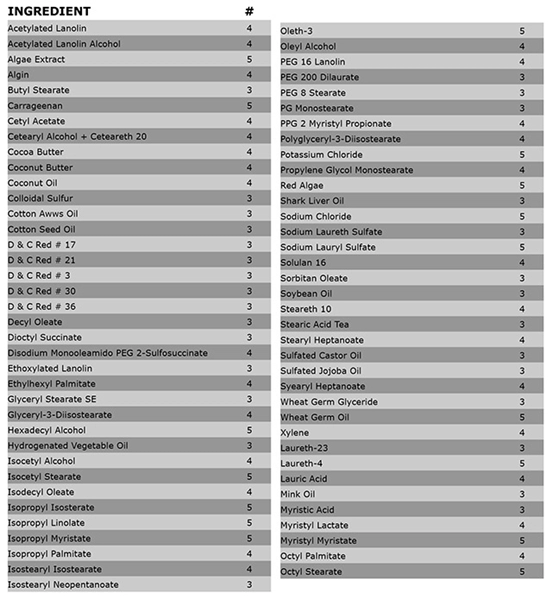
While not all comedogenic ingredients will clog everyone’s pores (as skin types vary), identifying these potential triggers can prevent unnecessary breakouts.
Sarah struggled with persistent breakouts despite using ‘natural’ products. After using the Pore Clogging Checker, she discovered her moisturizer contained algae extract—a common pore-clogging culprit. By switching to a non-comedogenic option, her skin cleared up within weeks.
How to Identify Pore Clogging Ingredients in Skincare
Deciphering a product’s ingredient list can feel like trying to read a foreign language. Many skincare labels include long, scientific names that are hard to recognize. Here are some tips for spotting pore-clogging ingredients:
- Look for Red Flags: Be cautious of heavy oils and waxes if you have oily or acne-prone skin.
- Check the Order: Ingredients are listed in descending order of concentration. If a comedogenic ingredient is near the top, it’s present in a higher amount.
- Use Online Tools: Pore-clogging checkers can do the heavy lifting for you by analyzing ingredient lists and identifying comedogenic risks.
Instead of spending hours researching each ingredient manually, a tool like PoreCloggingChecker.org simplifies this process. With just a few clicks, you can assess a product’s potential to clog pores and find safer alternatives.
The Role of a Pore Clogging Checker
How a Pore Clogging Checker Works
Ever wonder how a pore-clogging checker works? It’s simple. This powerful tool scans the ingredients in your skincare products and matches them against a database of known comedogenic substances.
Here’s how it works in three easy steps:
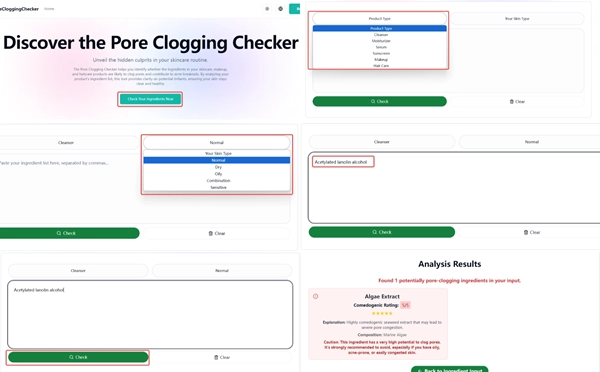
- Input Ingredients: Enter the full ingredient list from your product label.
- Database Cross-Check: The tool compares these ingredients against a list of pore-clogging substances.
- Result Analysis: You’ll receive a detailed breakdown of which ingredients are safe and which may clog pores.
Benefits of Using an Ingredient Checker for Skincare
Using a pore-clogging checker provides multiple benefits:
- Saves Time: No more manually researching ingredient lists.
- Prevents Breakouts: Avoid products with high comedogenicity that may lead to clogged pores and acne.
- Promotes Skin Health: Helps you select products that align with your skin type and needs.
- Educates Consumers: Learn more about skincare ingredients and their effects on your skin.
For example, PoreCloggingChecker.org provides detailed insights into ingredient functions and their likelihood of causing clogged pores. This empowers users to make informed decisions about their skincare routines.
Why Use a Pore Clogging Checker?
Skincare can be overwhelming, especially when navigating ingredient lists packed with technical terms. A pore-clogging checker helps bridge the gap between your skincare goals and the science behind product formulations. BBy leveraging tools like the non-comedogenic skincare checker on PoreCloggingChecker.org, you’re one step closer to acne-free, healthier skin.
Common Pore Clogging Ingredients to Watch Out For
Understanding the ingredients in your skincare products is essential for maintaining clear skin. While some ingredients nourish and protect your skin, others may clog pores, causing blackheads, whiteheads, and breakouts. Below, we’ll cover the most common pore-clogging ingredients, how to identify them, and how you can use online tools like the Pore Clogging Checker to make informed decisions about your skincare routine.
Most Common Ingredients That Can Clog Your Pores
Shea Butter: Deep hydration, but clogs pores in acne-prone skin.
Coconut Oil: Popular natural moisturizer, but highly comedogenic.
Algae Extracts: Anti-inflammatory yet pore-clogging for sensitive users.
Ethylhexyl Palmitate: Thickener often found in makeup; avoid for oily skin.
Marula Oil: Anti-aging benefits but dense, leading to clogged pores.
Lanolin: Common in lip balms but unsuitable for oily or acne-prone skin.
Pro Tip: Always cross-check your product labels using a pore-clogging checker tool like the one at PoreCloggingChecker.org to avoid sneaky comedogenic ingredients.
Is Dimethicone Pore Clogging?
Dimethicone is a silicone-based ingredient commonly used in skincare and makeup to create a smooth, silky texture. It forms a barrier on the skin, locking in moisture and improving the appearance of fine lines and texture.
However, dimethicone itself is not inherently pore-clogging. It’s non-comedogenic and often safe for acne-prone skin. The concern arises when dimethicone is combined with other comedogenic ingredients, trapping them under the skin.
If you’re unsure whether a product containing dimethicone is right for your skin, run its ingredient list through a pore-clogging checker for a more accurate assessment.
How to Use a Pore Clogging Ingredient Checker Effectively
A pore-clogging ingredient checker is a powerful tool to analyze your skincare products. Here’s how to use it step-by-step:
Step-by-Step Guide to Checking Skincare Ingredients
- Find the Ingredient List: Look for the full ingredient list on your product’s packaging or website.
- Enter Ingredients: Use a trusted tool like PoreCloggingChecker.org. Copy and paste the ingredients into the checker.
- Analyze Results: The tool will highlight any comedogenic ingredients and rate their pore-clogging potential.
- Adjust Your Routine: Replace products with high comedogenic ratings with non-comedogenic alternatives.
This simple process ensures you avoid acne triggers and find products tailored to your skin type. Ready to transform your skincare? Try our free tool now at PoreCloggingChecker.org and see the difference!
Avoiding Acne-Causing Ingredients with Online Tools
Online tools like the Pore Clogging Checker streamline the process of identifying problematic ingredients. By cross-referencing product labels with an extensive database of comedogenic ingredients, these tools help you:
- Avoid products likely to cause acne.
- Build a skincare routine tailored to your skin type.
- Save time and effort compared to manual research.
Example: If you’re trying a new moisturizer but notice breakouts, inputting the product’s ingredients into a pore-clogging checker can quickly reveal whether it’s the cause.
Active Ingredients for Clear, Non-Clogged Skin
In addition to avoiding pore-clogging ingredients, incorporating non-comedogenic active ingredients can help maintain clear skin. Here are some top choices:
1. Salicylic Acid
A beta-hydroxy acid (BHA), salicylic acid penetrates deep into pores to dissolve excess oil and dead skin cells, preventing blockages.
2. Niacinamide
This multi-tasking ingredient reduces inflammation, regulates oil production, and strengthens the skin barrier without clogging pores.
3. Hyaluronic Acid
Ideal for hydration, hyaluronic acid is lightweight and won’t clog pores, making it a great option for all skin types.
4. Retinol
A vitamin A derivative, retinol boosts cell turnover, keeping pores clear and reducing acne over time.
Not sure how to start? Take the guesswork out of ingredient research with PoreCloggingChecker.org. Our easy-to-use tool helps you identify acne-safe, non-comedogenic ingredients, making your skincare journey simpler and more effective.
Best Non-Comedogenic Ingredients for Skincare
If you’re looking for non-clogging options, consider incorporating the following ingredients into your routine:
- Aloe Vera: A soothing, hydrating ingredient that won’t block pores.
- Squalane: A lightweight oil that mimics your skin’s natural sebum without causing congestion.
- Zinc Oxide: Common in sunscreens, it provides protection while remaining non-comedogenic.
Tip: Use the Pore Clogging Checker to confirm that the products containing these ingredients are free from potential acne triggers.
Niacinamide: Friend or Foe for Clogged Pores?
Niacinamide, a form of Vitamin B3, is a versatile ingredient with multiple skin benefits. It reduces redness, regulates oil production, and minimizes pore appearance. Importantly, niacinamide is non-comedogenic, meaning it won’t clog your pores.
However, some individuals with extremely sensitive skin may experience irritation when using high concentrations of niacinamide. To ensure compatibility, patch-test products and use a checker tool to verify the formula’s overall safety for acne-prone skin.
Taking Control of Your Skincare with Pore Clogging Checkers
Achieving clear, healthy skin doesn’t have to feel like a guessing game. With the help of tools like a pore-clogging checker, you can take control of your skincare routine by understanding the ingredients in your products and their impact on your skin. By using these tools, you’ll not only prevent clogged pores and breakouts but also make more informed choices that cater to your skin’s unique needs.
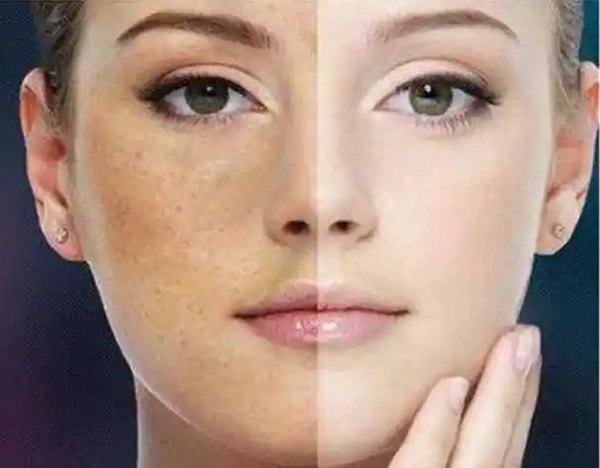
The journey to better skin starts with knowledge. By using PoreCloggingChecker.org, you can easily identify non-comedogenic options and build a skincare routine that supports long-term skin health. Let our tool simplify your journey to clearer skin.
FAQ Section
What Is the Best App to Check Ingredients in Skincare Products?
There are several great apps and tools for analyzing skincare ingredients, including PoreCloggingChecker.org, which is specifically designed to identify comedogenic ingredients. Other popular options include INCIdecoder and Skincarisma, both of which provide detailed information about ingredients and their effects on the skin.
Does Comedogenicity Mean a Product Will Always Cause Acne?
Not necessarily. Comedogenicity refers to the likelihood of an ingredient to clog pores. However, how a product affects your skin depends on factors such as your skin type, genetics, and how the product is used. People with oily or acne-prone skin are more susceptible to breakouts caused by comedogenic ingredients.
What Are Non-Comedogenic Products, and How Do They Help?
Non-comedogenic products are formulated to avoid clogging pores. They typically contain lightweight, breathable ingredients that minimize the risk of acne and irritation. Incorporating non-comedogenic products into your routine is especially beneficial for individuals with oily or acne-prone skin.
How Accurate Are Ingredient Checkers in Preventing Clogged Pores?
Ingredient checkers are highly effective at identifying comedogenic ingredients, but they aren’t foolproof. Factors like ingredient combinations and how a product is applied can still impact its potential to clog pores. Use these tools as part of a broader approach to skincare that includes proper cleansing, hydration, and sun protection.
Can I Rely Solely on a Pore Clogging Checker for Safe Products?
A pore-clogging checker is a valuable resource, but it’s not a replacement for other skincare practices. Always consider factors like your skin type and sensitivities, and consult with a dermatologist for personalized advice. Combining these tools with a consistent skincare routine will yield the best results.
How reliable is PoreCloggingChecker.org?
Our tool leverages a database built on peer-reviewed studies and expert-validated comedogenicity ratings. While no tool can guarantee results for every skin type, our checker provides an accurate and science-backed starting point for improving your skincare routine.
Additional Sections
How to Check If Your Current Products Are Clogging Your Pores
If you suspect your current skincare products are causing breakouts, follow these steps:
- Review the Ingredient List: Use a pore-clogging checker to identify potential culprits.
- Eliminate Suspicious Products: Temporarily remove products with known comedogenic ingredients from your routine.
- Reintroduce Gradually: Reintroduce products one at a time to identify which ones are causing issues.
The Science Behind Comedogenicity Ratings
Comedogenicity ratings range from 0 (non-comedogenic) to 5 (highly comedogenic). These ratings are based on studies that measure an ingredient’s potential to clog pores. It’s important to note that these ratings are guidelines, not guarantees, as individual skin reactions can vary.
Best Practices for Choosing Non-Pore-Clogging Makeup and Skincare
- Look for “Non-Comedogenic” Labels: While not foolproof, this label is a good starting point.
- Avoid Heavy Oils: Steer clear of ingredients like coconut oil and lanolin if you’re acne-prone.
- Prioritize Lightweight Formulas: Opt for water-based or gel-based products that won’t weigh down your skin.
- Patch Test New Products: Test products on a small area of skin before full application to check for reactions.
- Use Online Tools: Tools like PoreCloggingChecker.org can help you vet products before buying.
Skincare isn’t one-size-fits-all, but tools like the Pore Clogging Checker make it easier to tailor your routine to your unique skin needs. By understanding the ingredients in your products and their potential to clog pores, you’re empowered to make choices that lead to healthier, clearer skin.
Take the first step toward better skincare by analyzing your current products with PoreCloggingChecker.org. Your journey to clear, confident skin starts here!